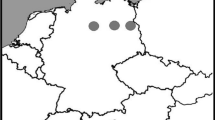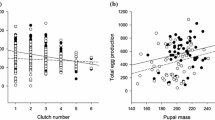Abstract
Interest in genetic variation at allozyme loci, especially at phosphoglucose isomerase (PGI), has considerably increased over recent decades. In this study, we investigated variation in food stress sensitivity and flight performance, two traits closely linked to individual fitness, across PGI genotypes in the sooty copper butterfly Lycaena tityrus. PGI genotype significantly affected growth rate and pupal mass, but had no overall effect on development time or flight performance. A significant genotype × sex × feeding treatment interaction showed that females from the rarest genotypes showed the strongest increase in development time under food stress. At the same time, these females exhibited the weakest reduction in body mass compared to non food-stressed individuals, while the most common PGI genotypes showed the highest reduction (significant interaction between genotype and feeding treatment). Such results suggest that effects of food stress on pupal mass may not pose a particularly strong selective pressure in L. tityrus. Generally, sex-specific differences in and effects of food stress on life-history traits were as expected, with, e.g., males showing a more rapid development, lower pupal mass and better flight performance than females.


Similar content being viewed by others
References
Arendt J (1997) Adaptive intrinsic growth rates: an integration across taxa. Q Rev Biol 72:149–177
Barnes PT, Laurie-Ahlberg CC (1986) Genetic variability of flight metabolism in Drosophila melanogaster. III. Effects of Gpdh isoenzymes and environmental temperature on power output. Genetics 112:267–294
Bauerfeind SS, Fischer K (2005) Effects of food stress and density in different life stages on reproduction in a butterfly. Oikos 111:514–524
Berrigan D, Charnov E (1994) Reaction norms for age and size at maturity in response to temperature: a puzzle for life historians. Oikos 70:474–478
Berwaerts K, Van Dyck H (2004) Take-off performance under optimal and suboptimal thermal conditions in the butterfly Pararge aegeria. Oecologia 141:536–545
Berwaerts K, Van Dyck H, Aerts P (2002) Does flight morphology relate to flight performance? An experimental test with the butterfly Pararge aegeria. Funct Ecol 16:484–491
Blanckenhorn WU (1999) Different growth responses to temperature and resource limitation in three fly species with similar life histories. Evol Ecol 13:395–409
Blanckenhorn WU (2000) The evolution of body size: what keeps organisms small? Q Rev Biol 75:385–407
Carroll AL (1994) Interactions between body size and mating history influence the reproductive success of males of a tortricid moth, Zeiraphera canadensis. Can J Zool 72:2124–2132
Chippindale AK, Alipaz JA, Chen HW, Rose MR (1997) Experimental evolution of accelerated development in Drosophila. I. Developmental speed and larval survival. Evolution 51:1536–1551
Chippindale AK, Ngo AL, Rose MR (2003) The devil in the details of life-history evolution: instability and reversal of genetic correlations during selection on Drosophila development. J Genet 82:133–145
Dahlhoff EP, Rank NE (2000) Functional and physiological consequences of genetic variation at phosphoglucose isomerase: heat shock protein expression is related to enzyme genotype in a montane beetle. Proc Natl Acad Sci USA 97:10056–10061
Dahlhoff EP, Rank NE (2007) The role of stress proteins in responses of a montane willow leaf beetle to environmental temperature variation. J Biosci 32:477–488
Delisle J, Hardy M (1997) Male larval nutrition influences the reproductive success of both sexes of the spruce budworm, Choristoneura fumiferana (Lepidoptera: Tortricidae). Funct Ecol 11:451–463
Ebert G, Rennwald E (1991) Die Schmetterlinge Baden-Württembergs. Ulmer, Stuttgart
Fagerström T, Wiklund C (1982) Why do males emerge before females? Protandry as a mating strategy in male and female butterflies. Oecologia 52:164–166
Fischer K, Fiedler K (2000a) Response of the copper butterfly Lycaena tityrus to increased leaf nitrogen in natural food-plants: evidence against the nitrogen limitation hypothesis. Oecologia 124:235–241
Fischer K, Fiedler K (2000b) Sex-related differences in reaction norms in the butterfly Lycaena tityrus (Lepidoptera: Lycaenidae). Oikos 90:372–380
Fischer K, Fiedler K (2001a) Effects of larval starvation on adult life-history traits in the butterfly species Lycaena tityrus (Lepidoptera: Lycaenidae). Entomol Gen 25:249–254
Fischer K, Fiedler K (2001b) Sexual differences in life-history traits in the butterfly Lycaena tityrus: a comparison between direct and diapause development. Entomol Exp Appl 100:325–330
Fordyce JA, Shapiro AM (2003) Another perspective on the slow-growth/high-mortality hypothesis: chilling effects on swallowtail larvae. Ecology 84:263–268
Fry JD, Donlon K, Saweikis M (2008) A worldwide polymorphism in Aldehyde dehydrogenase in Drosophila melanogaster: evidence for selection mediated by dietary ethanol. Evolution 62:66–75
Haag CR, Saastamoinen M, Marden JH, Hanski I (2005) A candidate locus for variation in dispersal rate in a butterfly metapopulation. Proc R Soc Lond B 272:2449–2456
Harris H, Hopkinson DA (1978) Handbook of enzyme electrophoresis in human genetics. North-Holland, Amsterdam
Hebert PDM, Beaton MJ (1993) Methodologies for allozyme analysis using cellulose acetate electrophoresis. Helena Laboratories Beaumont, TX
Honek A (1993) Intraspecific variation in body size and fecundity in insects: a general relationship. Oikos 66:483–492
Karl I, Fischer K (2009) Altitudinal and environmental variation in lifespan in the Copper butterfly Lycaena tityrus. Funct Ecol 23:1132–1138
Karl I, Lorenz MW, Fischer K (2007) Energetics of reproduction: consequences of divergent selection on egg size, food limitation, and female age for egg composition and reproductive effort in a butterfly. Biol J Linn Soc 91:403–418
Karl I, Janowitz SA, Fischer K (2008a) Altitudinal life-history variation and thermal adaptation in the copper butterfly Lycaena tityrus. Oikos 117:778–788
Karl I, Schmitt T, Fischer K (2008b) Phosphoglucose isomerase genotype affects life-history traits and cold stress resistance in a copper butterfly. Funct Ecol 22:887–894
Karl I, Schmitt T, Fischer K (2009) Genetic differentiation between alpine and lowland populations of a butterfly is related to PGI enzyme genotype. Ecography 32:488–496
Lorenz MW (2007) Oogenesis-flight syndrome in crickets: age-dependent egg production, flight performance, and biochemical composition of the flight muscles in adult female Gryllus bimaculatus. J Insect Physiol 53:819–832
McMillan DM, Fearnley SL, Rank NE, Dahlhoff EP (2005) Natural temperature variation affects larval survival, development and Hsp70 expression in a leaf beetle. Funct Ecol 19:844–852
Merckx T, Karlsson B, Van Dyck H (2006) Sex- and landscape-related differences in flight ability under suboptimal temperatures in a woodland butterfly. Funct Ecol 20:436–441
Metcalfe NB, Monaghan P (2001) Compensation for a bad start: grow now, pay later? Trends Ecol Evol 16:254–260
Munch SB, Conover DO (2003) Rapid growth results in increased susceptibility to predation in Menidia menidia. Evolution 57:2119–2127
Neargarder G, Dahlhoff EP, Rank NE (2003) Variation in thermal tolerance is linked to phosphoglucose isomerase genotype in a montane leaf beetle. Funct Ecol 17:213–221
Ochando MD, Ayala FJ (1999) Fitness of wild-caught Drosophila melanogaster females: allozyme variants of GPDH, ADH, PGM, and EST. Genetica 105:7–18
Oliveira GA, Baptista DL, Guimaraes-Motta H, Almeida IC, Masuda H, Atella GC (2006) Flight-oogenesis syndrome in a blood-sucking bug: biochemical aspects of lipid metabolism. Arch Insect Biochem Physiol 62:164–175
Orsini L, Wheat CW, Haag CR, Kvist J, Frilander MJ, Hanski I (2009) Fitness differences associated with Pgi SNP genotypes in the Glanville fritillary butterfly (Melitaea cinxia). J Evol Biol 22:367–375
Patarnello T, Battaglia B (1992) Glucosephosphate isomerase and fitness––effects of temperature on genotype dependent mortality and enzyme activity in 2 species of the genus Gammarus (Crustacea, Amphipoda). Evolution 46:1568–1573
Pigliucci M (2004) Studying the plasticity of phenotypic integration in a model organism. In: DeWitt TJ, Scheiner SM (eds) Phenotypic plasticity: functional and conceptual approaches. Oxford University Press, New York, pp 155–175
Pigliucci M, Preston K (2004) Phenotypic integration: studying the ecology and evolution of complex phenotypes. Oxford University Press, New York
Rank NE, Dahlhoff EP (2002) Allele frequency shifts in response to climate change and physiological consequences of allozyme variation in a montane insect. Evolution 56:2278–2289
Rank NE, Bruce DA, McMillan DM, Barclay C, Dahlhoff EP (2007) Phosphoglucose isomerase genotype affects running speed and heat shock protein expression after exposure to extreme temperatures in a montane willow beetle. J Exp Biol 210:750–764
Roff DA (1992) The evolution of life histories: theory and analysis. Chapman & Hall, New York
Roff DA (2002) Life history evolution. Sinauer Associates, Sunderland
Saastamoinen M (2007) Life-history, genotypic, and environmental correlates of clutch size in the Glanville fritillary butterfly. Ecol Entomol 32:235–242
Saastamoinen M, Hanski I (2008) Genotypic and environmental effects on flight activity and oviposition in the Glanville fritillary butterfly. Am Nat 171:E701–E712
Saastamoinen M, Ikonen S, Hanski I (2009) Significant effects of Pgi genotype and body reserves on lifespan in the Glanville fritillary butterfly. Proc R Soc Lond B 276:1313–1322
Slatkin M (1987) Gene flow and the geographic structure of natural populations. Science 236:787–792
Tolman T, Lewington R (1998) Die Tagfalter Europas und Nordwestafrikas. Franckh-Kosmos, Stuttgart
Van Dyck H, Matthysen E (1998) Thermoregulatory differences between phenotypes in the speckled wood butterfly: hot perchers and cold patrollers? Oecologia 114:326–334
Van Dyck H, Wiklund C (2002) Seasonal butterfly design: morphological plasticity among three developmental pathways relative to sex, flight and thermoregulation. J Evol Biol 15:216–225
Van Dyck H, Matthysen E, Wiklund C (1998) Phenotypic variation in adult morphology and pupal colour within and among families of the speckled wood butterfly Pararge aegeria. Ecol Entomol 23:465–472
Watt WB (1983) Adaptation at specific loci. II. Demographic and biochemical elements in the maintenance of the Colias PGI polymorphism. Genetics 103:691–724
Watt WB (1985) Bioenergetics and evolutionary genetics––opportunities for new synthesis. Am Nat 125:118–143
Watt WB (1992) Eggs, enzymes, and evolution––natural genetic variants change insect fecundity. Proc Natl Acad Sci USA 89:10608–10612
Watt WB, Cassin RC, Swan MS (1983) Adaptation at specific loci. III. Field behaviour and survivorship differences among Colias PGI genotypes are predictable from in vitro biochemistry. Genetics 103:725–739
Watt WB, Carter PA, Blower SM (1985) Adaptation at specific loci. IV. Differential mating success among glycolytic allozyme genotypes of Colias butterflies. Genetics 109:157–175
Watt WB, Donohue K, Carter PA (1996) Adaptation at specific loci. VI. Divergence vs parallelism of polymorphic allozymes in molecular function and fitness-component effects among Colias species (Lepidoptera, Pieridae). Mol Biol Evol 13:699–709
Wheat CW, Watt WB, Pollock DD, Schulte PM (2006) From DNA to fitness differences: sequences and structures of adaptive variants of Colias phosphoglucose isomerase (PGI). Mol Biol Evol 23:499–512
Acknowledgments
Financial support was provided by the German Research Council (DFG grant no. Fi 846/1-4 to K.F.).
Author information
Authors and Affiliations
Corresponding author
Rights and permissions
About this article
Cite this article
Karl, I., Hoffmann, K.H. & Fischer, K. Food stress sensitivity and flight performance across phosphoglucose isomerase enzyme genotypes in the sooty copper butterfly. Popul Ecol 52, 307–315 (2010). https://doi.org/10.1007/s10144-009-0191-z
Received:
Accepted:
Published:
Issue Date:
DOI: https://doi.org/10.1007/s10144-009-0191-z




